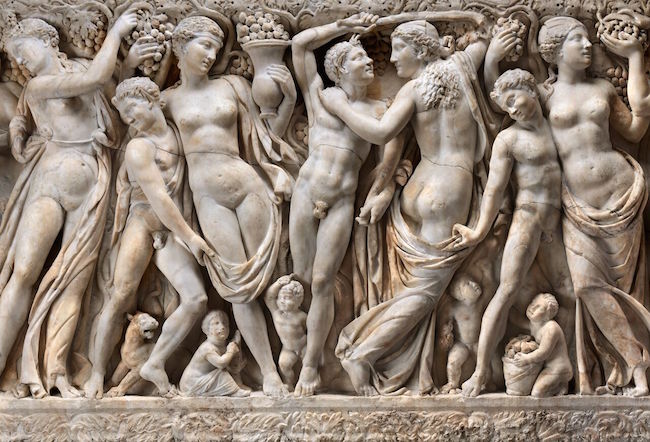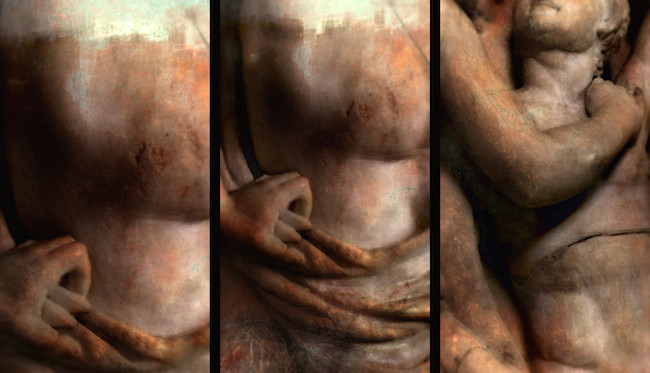Visual Arts Review: “Life, Death & Revelry” at the Gardner Museum
Life, Death & Revelry explores the aura of the Farnese Sarcophagus from several points of view, including those of the conservators who recently cleaned it of decades of accumulated grime.
Life, Death & Revelry at the Gardner Museum, Boston, MA, through September 3.

A segment of the Farnese Sarcophagus. Photo: Isabella Stewart Gardner Museum, Boston, MA.
By Peter Walsh
The monumental Farnese Sarcophagus, centerpiece of the Gardner Museum exhibition Life, Death & Revelry, was made by anonymous sculptor — or, more likely, a group of artisans — possibly of Greek origins, probably in Hellenized Western Turkey around 225 AD. The subject matter: a dance of satyrs and maenads and scenes from the life of Dionysus (Bacchus in the Roman tradition), which had been one of the most popular and often used decorative themes in Greek, Etruscan, and Roman art for centuries. It was, in its original context, a fairly standard and typical product: a high status item designed for export to wealthy clients around the empire.
But who has owned a work of art, and where, and why, and what it has meant over its history can often mean more than the artist who created it or even the work itself. The history of a work — “provenance” is the technical term — creates an intangible aura around the piece and can increase, by many times, the price a collector is willing to pay for it.
Life, Death & Revelry explores the aura of the Farnese Sarcophagus from several points of view, including those of the conservators who recently cleaned off decades of its accumulated grime. For the exhibition, the work has been moved from its usual place — “wedged between columns in the Palace courtyard,” into Hostetter Gallery, where all sides of the work can be seen for the first time in generations. There it is also be “in conversation” with Maenads & Satyrs, a 3D video installation by 2012 Gardner Artists-in-Residence OpenEndedGroup, a digital art collective. The video’s soundtrack is composed by Kaija Saariaho and performed by cellist Yeesun Kim of the Borromeo Quartet.
The Romans were pathologically afraid of being forgotten and their empire was, and still is, littered with their monuments to themselves — tombs and public buildings designed to remind their fellow citizens and all their descendants how wealthy and important they were when they were alive. Unfortunately, any hopes of identifying the original owners of this particular sarcophagus vanished with its lost lid, which may have depicted a husband and wife, reclining as if at a Roman-style dinner.
Unearthed around 1535 in Tivoli, an ancient resort town near Rome once favored by such celebrities at the Emperors Augustus and Hadrian and the poets Horace and Catullus, the sarcophagus was rediscovered by what the museum somewhat euphemistically calls “amateur archaeologists” — part of a network of excavators who dug through ancient sites to supply the insatiable Renaissance demand for ancient sculpture. For centuries Roman remains, even major monuments like the Coliseum, were looted for building materials. Marble sculptures, often in a battered state, were used as filler on construction sites or burned for lime.
The revival of interest in all things related to the ancient world of the Greeks and Romans marked the cultural turning of the Renaissance. As soon as they reached daylight, monumental pieces like this sarcophagus, long buried and forgotten, were eagerly snapped up by Italy’s leading families.
The Gardner’s sarcophagus was acquired by Cardinal Alessandro Farnese, grandson of Pope Paul III, members of a very grand family indeed. The Farnese took the work to Rome to become part of the growing Farnese collection. Later it passed through their heirs to the Queen of Spain, Elisabetta Farnese, last of the Farnese direct line, to Ferdinanand di Bourbon, King of the Two Sicilies, to Charles de Bourbon, who ruled as King Charles III of Spain, and eventually to the Imperial Vatican Museum, where it was transported by the Napoleonic commission then overseeing Rome. Later it was returned to the Palazzo Farnese by order of Pope Pius VII, remaining in the Bourbon family until 1897, when it was sold to the art dealer Ortensio Vitalinini.
Archaeologist Richard Norton, son of Harvard Professor Charles Eliot Norton, urged the Boston Gardners to buy it. Isabella’s husband John L. Gardner, Jr., completed the purchase for 52,000 lire at the end of 1897. After John’s death, Isabella installed it in the courtyard of her newly constructed Fenway Court in 1901.

A glimpse of the hands of the maenads on the Farnese Sarcophagus. Photo: Marc Downie and Paul Kaiser / OpenEndedGroup.
With characteristic enthusiasm, the late Cornelius Vermeule, former Curator of Classical Art at the Museum of FineArts, Boston, described the sarcophagus as the “most important” work of art in the Gardner collection. (Most non-classicists would give that honor to Titian’s “Rape of Europa,” widely considered the most important Italian painting in North America.) Despite the work’s considerable charms and imposing presence, it is clearly a piece produced for the market “at a price.” The deep relief in the front’s frieze of revelers suggests the labor-saving use of the drill and the back, which was clearly designed to face a wall where it would not be seen, is rendered in a flat, almost summary relief. The sinuous, abstract patterns created by the reveling figures, which cram all the available space to the edges of the frame, suggest the growing influx of “barbarian” taste in the later Roman Empire and the conventionalized bodies, with their less than classical proportions, seems to point towards the abstracted figures of the Middle Ages.
Nonetheless, the work has, in its modern life, been compelling, suggesting, to artists and art lovers of the 17th and 18th centuries, the glory of a vanished world whose cultural heights seemed beyond their climbing skills. The sarcophagus spent a considerable amount of time gracing the gardens of the famous Palazzo Farnese in Rome (a hole was cut to let out rainwater) and, as the exhibition shows, it inspired many artists visiting the Farnese grounds, some of whom sketched the work in situ. Certainly, the OpenEndedGroup’s video, recorded in 3-D effect (requiring special glasses to view), is intriguing. As if fascinated by the deep voids in the front of the work, the camerawork explores the surface in dramatic closeup, entering the spaces between figures as if they were caves or deep passages in a marble maze. Faces emerge in startling relief. Together with the abstract musical score, the approach emphasizes the strangeness of the piece, as if it speaks from a distance of time so great it has become an alien presence.
Other parts of the elegant installation deal with the recent conservation of the Farnese Sarcophagus. Among other things, the process recovered traces of ancient paint that suggested the work, given the significance of its subject matter applied to a funerary monument, was, like most classical marbles, originally brightly painted. Its use of the Dionysian myths may have suggested the eternal cycles of birth, maturity, death, and rebirth. Rarely is the public given a chance to see an art work from so many contrasting points of view. For this alone, the Gardner collaborators deserve high praise.
Peter Walsh has worked as a staff member or consultant to such museums as the Harvard Art Museums, the Museum of Fine Arts, Boston, the Davis Museum at Wellesley College, The Metropolitan Museum of Art, the National Gallery of Art, and the Boston Athenaeum. As an art historian and media scholar, he has lectured in Boston, New York, Chicago, Toronto, San Francisco, London, and Milan, among other cities and has presented papers at MIT eight times. He has published in American and European newspapers, journals, and in anthologies. In recent years, he began a career as an actor and has since worked on more than eighty projects, including theater, national television, and such award-winning films as Spotlight, The Second Life, and Brute Sanity. He is a graduate of Oberlin College and Harvard University.
Tagged: Death & Revelry, Farnese Sarcophagus, Gardner Museum
